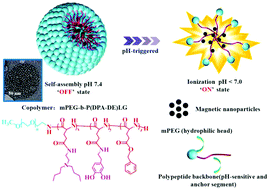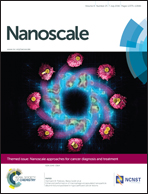pH-Responsive biodegradable polymeric micelles with anchors to interface magnetic nanoparticles for MR imaging in detection of cerebral ischemic area†
Abstract
A novel type of pH-responsive biodegradable copolymer was developed based on methyloxy-poly(ethylene glycol)-block-poly[dopamine-2-(dibutylamino) ethylamine-L-glutamate] (mPEG-b-P(DPA-DE)LG) and applied to act as an intelligent nanocarrier system for magnetic resonance imaging (MRI). The mPEG-b-P(DPA-DE)LG copolymer was synthesized by a typical ring opening polymerization of N-carboxyanhydrides (NCAs-ROP) using mPEG-NH2 as a macroinitiator, and two types of amine-terminated dopamine groups and pH-sensitive ligands were grafted onto a side chain by a sequential aminolysis reaction. This design greatly benefits from the addition of the dopamine groups to facilitate self-assembly, as these groups can act as high-affinity anchors for iron oxide nanoparticles, thereby increasing long-term stability at physiological pH. The mPEG moiety in the copolymers helped the nanoparticles to remain well-dispersed in an aqueous solution, and pH-responsive groups could control the release of hydrophobic Fe3O4 nanoparticles in an acidic environment. The particle size of the Fe3O4-loaded mPEG-b-P(DPA-DE)LG micelles was measured by dynamic light scattering (DLS) and cryo-TEM. The superparamagnetic properties of the Fe3O4-loaded mPEG-b-P(DPA-DE)LG micelles were confirmed by a superconducting quantum interference device (SQUID). T2-weighted magnetic resonance imaging (MRI) of Fe3O4-loaded mPEG-b-P(DPA-DE)LG phantoms exhibited enhanced negative contrast with an r2 relaxivity of approximately 106.7 mM−1 s−1. To assess the ability of the Fe3O4-loaded mPEG-P(DE-DPA)LG micelles to act as MRI probes, we utilized a cerebral ischemia disease rat model with acidic tissue. We found that a gradual change in contrast in the cerebral ischemic area could be visualized by MRI after 1 h, and maximal signal loss was detected after 24 h post-injection. These results demonstrated that the Fe3O4-loaded mPEG-b-P(DPA-DE)LG micelles can act as pH-triggered MRI probes for diagnostic imaging of acidic pathological tissues.

- This article is part of the themed collection: Nanoscale approaches for cancer diagnosis and treatment

 Please wait while we load your content...
Please wait while we load your content...